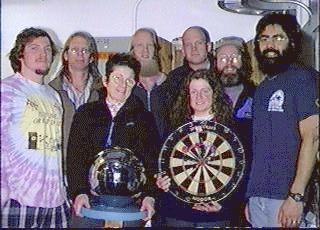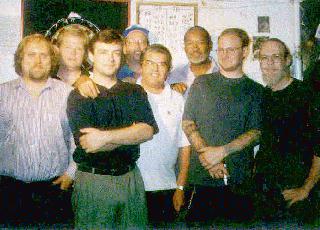|
The Original Darts News & Info Web Site ...est. 1994! |
|
||||||||
by Ed Edwards Mr. Eagan's Restaurant, Washington D.C., 12:30am. Dart match innovation opened a fresh page as the TDI League of the District of Columbia hosted the first trans-global steel dart match, with a group at the South Pole (Antarctica), utilizing Internet audio communication. Months of preparation had culminated in a match that lasted a mere two hours, on Saturday, August 10, 1996. The seeds of inspiration for this event were varied and spanned 23 years. The Washington Area Darts Association, being run out of what is now Mr. Eagan's, shot its first telephone match against Dallas in 1974. TDI, celebrating its 20th anniversary, had originally been co-founded by Jimmy Eagan in 1976 as a travel league. I, personally, had set up a computer BBS in May of `95, prompted by the potential of greater inter-communication between our various regional leagues. All of that had lead to the "what". The "who" was prompted by a story compiled for the most part by Katy McNitt describing a loose league of six scientific research stations in Antarctica. They played darts by high frequency radio every Friday night during their winter (6 months of dark, best temperatures reach -20 Fahrenheit). Katy had been a researcher and one of the participants. This story was presented in the New South Polar Times (a cyber publication) by Katie Wallet. Electronic mail to Katie, a science curriculum coordinator for Spotsylvania County Virginia, and her co-editor, George Duckett from Deakin University, Australia, elicited a referral to Katharine Caesar, a league player at the pole. The above process of finding someone who was on site and could provide me with an assessment of their physical capabilities and their degree of interest had taken two months of active pursuit. Inquiries had been made of the British Royal Academy, the British Antarctic Survey, the Australian Science Academy, the National Science Foundation and the U.S. Navy. I have to admit that getting a confirmation of a team's willingness to participate put a grin on my face for the whole day. Katharine and I communicated frequently to check out hardware compatibility, software integration, individual work schedules, the window of opportunity for their satellite, etc. Even time zone differences were a significant factor. Our original goal was to try for a connection which would give us both audio and real-time video. We soon discovered that because of physical limitations we would have to settle for audio-only but by this time the comfortable rapport and camaraderie that had developed easily made up for any disappointment. Numerous efforts were made over the next few weeks to run a test link. Work conflicts, Acts of God, and the 19 hour crash of AOL all seemed to conspire against us. Each end, on more than one occasion, had stood under the clock tower sporting a red carnation but had failed to make contact. We had come close to a fleeting glimpse, but no embrace. Finally, on Friday, August 9th, five hours before the time initially targeted for our match, we heard voices from the pole. Chris Bristol, who was handling our technical end, had established a "chat" room entitled "DC to South Pole Dart Match" within the IRC network. At approximately 25 minutes past seven EST we were joined by Ric Ramos, NOAA Officer in Charge at the Amundsen-Scott Research Station, South Pole, Antarctica. It was difficult to restrain the enthusiasm but a measure of quiet was necessary because too much noise on either end would break up the signal. Chris happened to mention that, since we didn't need the expanded bandwidth required for video, we were not at his office (which had been our planned location), hence the noise. From what sounded to be over Ric's shoulder we could hear Katharine's distinctive Floridian accent exclaim "They're in a baarr!" Her feigned exasperation sounded as though we had touched a nerve on her "miss" list. Chris and Ric compared notes on who was using which version of what software and it was quickly resolved that we had enough of a link to go for "real". We agreed to reassemble in four hours with our respective squads. Huddled around the speakers of the computer, at midnight we went into IRC. Shortly thereafter we had connection. Chris and Ric were again coordinating things. It was truly great to hear those folks who had been, up to that point, the other end of e-mail. We traded salutations and, after some format confirmation, presented our rosters. My cork to begin the game was relayed as being closer to their bristle dartboard than ours. South Pole led off. Because of some glitches in software version compatibility and the demise of their satellite link we were only able to play one game and it was extremely close. John "JY" Yarborough from the TDI squad, left with double top, took it out on his first dart. At that point South Pole was sitting at 24. We tried to squeeze in more socializing but by this stage the satellite link was disintegrating rapidly. When the signal eventually gave out we reverted to e-mail for a final goodnight, wishing them a safe-home. The South Pole squad had trudged from their main dome facility to the external building that had room enough in which to play and a computer with a sound card. Their current temperature was -60F with a wind chill of -125F. Laboring against zero visibility, they managed the distance by flashlight and radio.
1. Doc Betty Carlisle, station physician
1. Ed Edwards (who's idea this all was and former director) Not enough can be said to highlight the regard and respect that these folks deserve in the pursuit of scientific endeavor and/or personal challenge. They're laboring down there under barbarous conditions. The weather is as bad as it gets on the planet and it's been dark for four months. So, to relieve the pressures, break the boredom, and plain ole have a good time, they play darts. Says something for the sport. Plaudits to Internet Phone (the software we used) but we would recommend version 4 because of the full duplex capability. Katharine Caesar - Age, 27: Hometown, Lake City, Florida Education: BS in Zoology, Auburn University, MSc in Zoology, University of Canterbury Christchurch NZ I have worked at the Pole for 3 summer season as a communications operator and got into Internet communications through my work at the Pole. Currently I am working in the Logistics department for the winter season. The only darts experience I had before this year came from the annual staff- grad. student darts match in the Zoology Dept. at Canterbury. This winter the annual Continental HF darts match got into full swing at the end of May. South Pole has played most Friday nights against teams from Scott Base (NZ), Mawson Station (Australia), Davis Station (Australia), Casey Station (Australia), and McMurdo Station (USA). Ricardo Ramos - Age, 33: Raised, Klamath Falls, OR: Married- wife's name, Melissa (wintering-over at McMurdo Station) Occupation: Commissioned Officer in NOAA: rank - Lieutenant (Junior Grade) Assignment at the Pole: Officer-in-Charge of NOAA's Climate Monitoring and Diagnostics Laboratory's Clean Air Facility The thing I miss the most besides my wife (Melissa and I will be celebrating our one year anniversary apart): FRESH VEGETABLES! and watching NFL football. Hobbies/Interests at the Pole: reading, playing pool, DARTS (although I did not play regularly before coming here), and surfing the Web. I recently completed my own web pages. Check them out at: http://205.174.118.254/nspt/ric/index.htm (Professional page) and http://205.174.118.254/nspt/ric/ramospag.htm (Personal page). Chris Bristol - I'm 26 years old and was taught to play darts by my (English/Canadian) grandfather at an early age, 8 or 9. I've been playing in TDI for 3 years and just joined a WADA Monday night team this summer. I'm not a real good dart player but can generally hold my own. I grew up near Dayton, Ohio. I started messin' about with computers in 1978, age 8, and have been getting paid to mess with them since 1984. I started with programming in dBase II and progressed to network installation and general hardware/software support. I moved to DC to work for Greenpeace in October of `92 and am currently the Systems Manager for McGraw-Hill Publishing in Washington. Ed Edwards - I'm 11 (have been for a long time and plan on staying 11 as long as I can). I've done building restoration and renovation, been a graphic artist, made stained glass windows, and lots of other stuff. I first shot league darts in 1972, served in various capacities for WADA, published CORK magazine (a local bi-monthly, circ. 2000) in `76, joined TDI in its 2nd season and in the 3rd season took over as director for the next 7 years. I devised the TDI individual 301 rating system that we boast as being the most accurate in existence, started the Bristle Board BBS in 1995, and am currently looking for a corporate sponsor for a weekly, ladies only, luck-of-the-draw, aptly christened the "Lady Luck". Incidentally, TDI stands for Tournament Darts International. As alluded to earlier, the league was originally begun in an effort to underwrite national and international travel for individuals and teams. It is not quite as presumptuous as might first appear, considering Jimmy's wife Jacque had been `72 National Women's Champion and was one of three local women selected by the USDA in `73 to travel to England for the News of the World Tournament. Nonetheless it has taken TDI 20 years to finally lend real credence to its name. Amundsen-Scott South Pole StationAmundsen-Scott South Pole Station is 840 miles from McMurdo Station and the coast of Antarctica. Its main structure is a geodesic dome, 55 feet high and 165 feet wide, attached to steel arches extending 80 feet from opposite sides. In the archways are bladders storing 225,00 gallons of fuel, a small clinic, generator room, a gym, the carpentry shop and parking garage. The SkyLab, a tunnel for seismology research, is connected to the dome via an archway. Under the dome are modular buildings, heating, snow-melting and research equipment, a dining room (the Galley) where most activities take place, a weight room, greenhouse, a communication center (the Comm), some computer terminal rooms, a library, a small shop, a big refrigeration room (requiring very little power), the upper berth and the berth annex where year-round residents live. About 160 people live at Amundsen-Scott in summer, and the current winter population is 26. The temperature has been reported to have dropped to -225F windchill. When it was built in 1975 the archways were completely above the ground. After years' of accumulating drifting snow, the archways are basically under the ground now, but the dome is visible from more than ten kilometers away if the weather is good. The station sits on a plateau and a common ailment for the newly arrived is acute mountain sickness resulting from a physiological altitude of 10,000 feet. About two hundred meters away is the Ceremonial Pole of the South Pole. In accordance with the Antarctic Treaty, whatever has been carried into Antarctica should be carried out. Human impact on the environment should be kept to a minimum. All garbage, from dead vehicles to coffee grounds, should be categorized and packed separately. Almost all waste to be shipped back to country of origin. The US has kept its presence there since 1957. |
| ||||||||
|
| |||||||||
|
Rick's Darts & Games America's Oldest Darts Pro Shop under same ownership, since 1974! |
Fine Quality Games. | ||||||||
|
Copyright Rick Osgood | |||||||||

